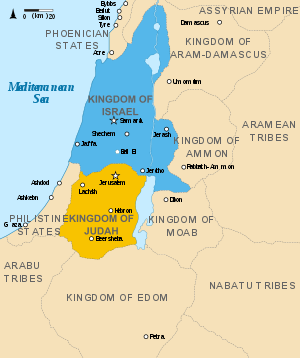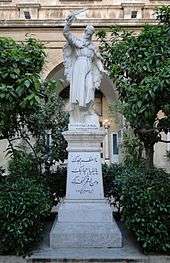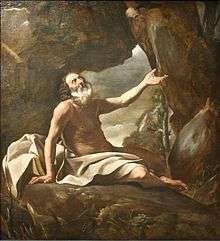Elijah
Elijah (/ɪˈlaɪdʒə/ ih-LY-jə; Hebrew: אֵלִיָּהוּ, Eliyahu, meaning "My God is Yahweh[6]/YHWH"[7][8]) or Greek form Elias (/ɪˈlaɪəs/ ih-LY-əs)[lower-alpha 1] was, according to the Books of Kings in the Hebrew Bible, a prophet and a miracle worker who lived in the northern kingdom of Israel[9] during the reign of King Ahab (9th century BC). In 1 Kings 18, Elijah defended the worship of the Hebrew God over that of the Canaanite deity Baal. God also performed many miracles through Elijah, including resurrection (raising the dead), bringing fire down from the sky, and entering Heaven alive "by fire".[10] He is also portrayed as leading a school of prophets known as "the sons of the prophets".[11] Following his ascension, Elisha, his disciple and most devoted assistant, took over his role as leader of this school. The Book of Malachi prophesies Elijah's return "before the coming of the great and terrible day of the LORD",[12] making him a harbinger of the Messiah and of the eschaton in various faiths that revere the Hebrew Bible. References to Elijah appear in Ecclesiasticus, the New Testament, the Mishnah and Talmud, the Quran, the Book of Mormon, the Doctrine and Covenants, and Bahá'í writings.
Elijah | |
|---|---|
_-_WGA00311.jpg) Prophet Elijah detailed in the Madonna and Child with Saints by Andrea di Bonaiuto | |
| Prophet Father of Carmelites | |
| Born | 900 BC Tishbe (possibly) |
| Died | 849 BC[1] (According to the Bible, Elijah was taken up into heaven by a chariot of fire, 2 Kings 2) |
| Venerated in | Judaism Christianity Islam |
| Feast | 20 July (Catholic Church[2], Eastern Orthodox Churches[3], and the Lutheran Church–Missouri Synod[4]) |
| Patronage |
|
In Judaism, Elijah's name is invoked at the weekly Havdalah rite that marks the end of Shabbat, and Elijah is invoked in other Jewish customs, among them the Passover Seder and the brit milah (ritual circumcision). He appears in numerous stories and references in the Haggadah and rabbinic literature, including the Babylonian Talmud.
The Christian New Testament notes that some people thought that Jesus was, in some sense, Elijah,[13] but it also makes clear that John the Baptist is "the Elijah" who was promised to come in Malachi 3:1; 4:5.[14] According to accounts in all three of the Synoptic Gospels, Elijah appeared with Moses during the Transfiguration of Jesus.
In Islam, Elijah or Ilyas appears in the Quran as a prophet and messenger of God, where his biblical narrative of preaching against the worshipers of Baal is recounted in a concise form.[15] Due to his importance to Muslims, Catholics, and Orthodox Christians, Elijah has been venerated as the patron saint of Bosnia and Herzegovina since 1752.[16]
Biblical accounts
According to the Bible, by the 9th century BC, the Kingdom of Israel, once united under Solomon, divided into the northern Kingdom of Israel and the southern Kingdom of Judah (which retained the historical capital of Jerusalem along with its Temple). Omri, King of Israel, continued policies dating from the reign of Jeroboam, contrary to religious law, that were intended to reorient religious focus away from Jerusalem: encouraging the building of local temple altars for sacrifices, appointing priests from outside the family of the Levites, and allowing or encouraging temples dedicated to Baal, an important deity in ancient Canaanite religion.[18][19] Omri achieved domestic security with a marriage alliance between his son Ahab and princess Jezebel, a priestess of Baal and the daughter of the king of Sidon in Phoenicia.[lower-alpha 2] These solutions brought security and economic prosperity to Israel for a time,[21] but did not bring peace with the Israelite prophets, who advocated a strict deuteronomic interpretation of the religious law.
Under Ahab's kingship tensions exacerbated. Ahab built a temple for Baal, and his wife Jezebel brought a large entourage of priests and prophets of Baal and Asherah into the country. In this context Elijah is introduced in 1 Kings 17:1 as Elijah "the Tishbite". He warns Ahab that there will be years of catastrophic drought so severe that not even dew will form, because Ahab and his queen stand at the end of a line of kings of Israel who are said to have "done evil in the sight of the Lord".
1st and 2nd Kings
No background for the person of Elijah is given except for his brief characterization as a "Tishbite". His name in Hebrew means "My God is Yahweh", and may be a title applied to him because of his challenge to worship of Baal.[22][23][24][25][26]
As told in the Hebrew Bible, Elijah's challenge is bold and direct. Baal was the Canaanite god responsible for rain, thunder, lightning, and dew. Elijah thus, when he initially announces the drought, not only challenges Baal on behalf of God himself, but he also challenges Jezebel, her priests, Ahab and the people of Israel.[27]
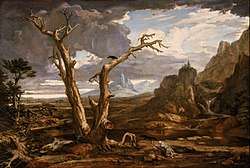
Widow of Zarephath
After Elijah's confrontation with Ahab, God tells him to flee out of Israel, to a hiding place by the brook Chorath, east of the Jordan, where he will be fed by ravens.[28][17] When the brook dries up, God sends him to a widow living in the town of Zarephath in Phoenicia.
When Elijah finds her and asks to be fed, she says that she does not have sufficient food to keep her and her own son alive. Elijah tells her that God will not allow her supply of flour or oil to run out, saying, "Do not be afraid ... For thus says the Lord the God of Israel: The jar of meal will not be emptied and the jug of oil will not fail until the day that the Lord sends rain on the earth."[29] She feeds him the last of their food, and Elijah's promise miraculously comes true. God gave her "manna" from heaven even while he was withholding food from his unfaithful people in the promised land.
Some time later the widow's son dies and the widow cries, "You have come to me to bring my sin to remembrance, and to cause the death of my son!"[30] Elijah prays that God might restore her son so that the trustworthiness of God's word might be demonstrated, and "[God] listened to the voice of Elijah; the life of the child came into him again, and he revived."[31] This is the first instance of raising the dead recorded in Scripture. This widow was granted the life of her son, the only hope for a widow in ancient society. The widow cried, "the word of the Lord in your mouth is truth."[32]
After more than three years of drought and famine, God tells Elijah to return to Ahab and announce the end of the drought: Not occasioned by repentance in Israel but by the command of the Lord, who had determined to reveal himself again to his people. While on his way, Elijah meets Obadiah, the head of Ahab's household, who had hidden a hundred Jewish prophets from Jezebel's violent purge. Obadiah fears that when he reports to Ahab about Elijah's whereabouts, Elijah would disappear, provoking Ahab to execute him. Elijah reassures Obadiah and sends him to Ahab.
Challenge to Baal
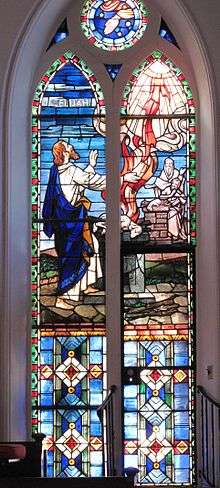
When Ahab confronts Elijah, he denounces him as being the "troubler of Israel" but Elijah takes notice of his hypocrisy and tells Ahab that he is the one who troubled Israel by allowing the worship of false gods. Elijah then berates both the people of Israel and Ahab for their acquiescence in Baal worship. "How long will you go limping with two different opinions? If the Lord is God, follow him; but if Baal, then follow him."[33] And the people were silent. The Hebrew for this word, "go limping" or "waver", is the same as that used for "danced" in 1 Kings 18, verse 26, where the prophets of Baal frantically dance. Elijah speaks with sharp irony about the religious ambivalence of Israel.
Elijah proposes a direct test of the powers of Baal and the Jewish God. The people of Israel, 450 prophets of Baal, and 400 prophets of Asherah are summoned to Mount Carmel. An altar is built for Baal. Wood is laid on the altar. An ox is slaughtered and cut into pieces; the pieces are laid on the wood. Elijah then invites the priests of Baal to pray for fire to light the sacrifice. They pray from morning to noon without success. Elijah ridicules their efforts. "At noon Elijah mocked them, saying, 'Cry aloud! Surely he is a god; either he is meditating, or he has wandered away, or he is on a journey, or perhaps he is asleep and must be awakened.'"[34] They respond by cutting themselves and adding their own blood to the sacrifice (such mutilation of the body was strictly forbidden in the Mosaic law). They continue praying until evening without success.
Elijah builds an altar from twelve stones, digs a huge trench around it, lays wood on it, slaughters another ox, cuts it up, and lays it on the wood. He then orders that the sacrifice and altar be drenched with water from "four large jars" poured three times, filling also the trench.[35] He asks God to accept the sacrifice. Fire falls from the sky, consuming the sacrifice, the stones of the altar itself, the earth and the water in the trench as well. Elijah then orders the deaths of the priests of Baal. Elijah prays earnestly for rain to fall again on the land. Then the rains begin, signaling the end of the famine.
Mount Horeb
Jezebel, enraged that Elijah had ordered the deaths of her priests, threatens to kill Elijah.[36] Later Elijah would prophesy about Jezebel's death, because of her sin. Elijah flees to Beersheba in Judah, continues alone into the wilderness, and finally sits down under a shrub, praying for death. He falls asleep under the tree; the angel of the Lord touches him and tells him to wake up and eat. When he awakens he finds bread and a jar of water. He eats, drinks, and goes back to sleep. The angel comes a second time and tells him to eat and drink because he has a long journey ahead of him.
Elijah travels for forty days and forty nights to Mount Horeb,[37] where Moses had received the Ten Commandments. Elijah is the only person described in the Bible as returning to Horeb, after Moses and his generation had left Horeb several centuries before. He seeks shelter in a cave. God again speaks to Elijah:[38] "What doest thou here, Elijah?". Elijah did not give a direct answer to the Lord's question but evades and equivocates, implying that the work the Lord had begun centuries earlier had now come to nothing, and that his own work was fruitless. Unlike Moses, who tried to defend Israel when they sinned with the golden calf, Elijah bitterly complains over the Israelites' unfaithfulness and says he is the "only one left". Up until this time Elijah has only the word of God to guide him, but now he is told to go outside the cave and "stand before the Lord." A terrible wind passes, but God is not in the wind. A great earthquake shakes the mountain, but God is not in the earthquake. Then a fire passes the mountain, but God is not in the fire. Then a "still small voice" comes to Elijah and asks again, "What doest thou here, Elijah?" Elijah again evades the question and his lament is unrevised, showing that he did not understand the importance of the divine revelation he had just witnessed. God then sends him out again, this time to Damascus to anoint Hazael as king of Aram, Jehu as king of Israel, and Elisha as his replacement.
- A statue of Elijah in the Cave of Elijah, Mount Carmel, Israel
- The Cave of Elijah, Mount Carmel, Israel
Vineyard of Naboth
Elijah encounters Ahab again in 1 Kings 21, after Ahab has acquired possession of a vineyard by murder. Ahab desires to have the vineyard of Naboth of Jezreel. He offers a better vineyard or a fair price for the land. But Naboth tells Ahab that God has told him not to part with the land. Ahab accepts this answer with sullen bad grace. Jezebel, however, plots a method for acquiring the land. She sends letters, in Ahab's name, to the elders and nobles who lived near Naboth. They are to arrange a feast and invite Naboth. At the feast, false charges of cursing God and Ahab are to be made against him. The plot is carried out and Naboth is stoned to death. When word comes that Naboth is dead, Jezebel tells Ahab to take possession of the vineyard.
God again speaks to Elijah and sends him to confront Ahab with a question and a prophecy: "Have you killed, and also taken possession?" and, "In the place where dogs licked up the blood of Naboth, dogs will also lick up your blood."[39] Ahab begins the confrontation by calling Elijah his enemy. Elijah responds by throwing the charge back at him, telling him that he has made himself the enemy of God by his own actions. Elijah then goes beyond the prophecy he was given and tells Ahab that his entire kingdom will reject his authority; that Jezebel will be eaten by dogs within Jezreel; and that his family will be consumed by dogs as well (if they die in a city) or by birds (if they die in the country). When Ahab hears this he repents to such a degree that God relents in punishing Ahab but will punish Jezebel and their son: Ahaziah.
Ahaziah
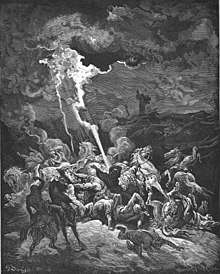
Elijah's story continues now from Ahab to an encounter with Ahaziah (2 Kings 1). The scene opens with Ahaziah seriously injured in a fall. He sends to the priests of Baalzebub in Ekron, outside the kingdom of Israel, to know if he will recover. Elijah intercepts his messengers and sends them back to Ahaziah with a message "Is it because there is no God in Israel that you are sending to inquire of Baal-zebub, the god of Ekron?"[37][40] Ahaziah asks the messengers to describe the person who gave them this message. They tell him he was a hairy man with a leather belt around his waist and he instantly recognizes the description as Elijah the Tishbite.
Ahaziah sends out three groups of soldiers to arrest Elijah. The first two are destroyed by fire which Elijah calls down from heaven. The leader of the third group asks for mercy for himself and his men. Elijah agrees to accompany this third group to Ahaziah, where he gives his prophecy in person. Ahaziah dies without recovering from his injuries in accordance with Elijah's word.[41]
Departure

According to 2 Kings 2:3–9, Elisha (Eliseus) and "the sons of the prophets" knew beforehand that Elijah would one day be assumed into heaven. Elisha asked Elijah to "let a double portion" of Elijah's "spirit" be upon him. Elijah agreed, with the condition that Elisha would see him be "taken".
Elijah, in company with Elisha, approaches the Jordan. He rolls up his mantle and strikes the water.[42] The water immediately divides and Elijah and Elisha cross on dry land. Suddenly, a chariot of fire and horses of fire appear[37] and Elijah is lifted up in a whirlwind. As Elijah is lifted up, his mantle falls to the ground and Elisha picks it up.
Final mention: 2nd Chronicles
Elijah is mentioned once more in 2 Chronicles 21:12, which will be his final mention in the Hebrew Bible. A letter is sent under the prophet's name to Jehoram of Judah. It tells him that he has led the people of Judah astray in the same way that Israel was led astray. The prophet ends the letter with a prediction of a painful death. This letter is a puzzle to readers for several reasons. First, it concerns a king of the southern kingdom, while Elijah concerned himself with the kingdom of Israel. Second, the message begins with "Thus says YHVH, God of your father David..." rather than the more usual "...in the name of YHVH the God of Israel." Also, this letter seems to come after Elijah's ascension into the whirlwind. Michael Wilcock, formerly of Trinity College, Bristol, suggests a number of possible reasons for this letter, among them that it may be an example of a better known prophet's name being substituted for that of a lesser known prophet.[43] John Van Seters, however, rejects the letter as having any connection with the Elijah tradition.[44] However, Wilcock argues that Elijah's letter "does address a very 'northern' situation in the southern kingdom", and thus is authentic.[45]
The Christian end of Elijah in Malachi
|
"Lo, I will send you the prophet Elijah before the great and terrible day of the Lord comes. He will turn the hearts of parents to their children and the hearts of children to their parents, so that I will not come and strike the land with a curse." |
| — Malachi 4:5–6, New Revised Standard Version |
While the final mention of Elijah in the Hebrew Bible is in the Book of Chronicles, the Christian Bible's ordering of the books of the Septuagint places the Book of Malachi, which prophesies a messiah, before the Gospels[46] and means that Elijah's final Old Testament appearance is in the Book of Malachi, where it is written, "Lo, I will send you the prophet Elijah before the great and terrible day of the Lord comes."[47] That day is described as the burning of a great furnace, "... so that it will leave them neither root nor branch."[48] In Christianity it is traditionally believed that Elijah's appearance during the transfiguration of Jesus fulfilled this prophecy. Moreover, in the Gospel of Matthew, Jesus identifies John the Baptist as the spiritual successor to Elijah: "and if you are willing to accept it, he is Elijah who is to come."[49]
One theory of textual analysis
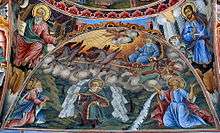
According to Susanne Otto, the Elijah stories were added to the Deuteronomistic History in four stages. The first stage dates from the final edition of the History, about 560 BC, when the three stories of Naboth's vineyard, the death of Ahaziah, and the story of Jehu's coup were included to embody the themes of the reliability of God's word and the cycle of Baal worship and religious reform in the history of the Northern Kingdom. The narratives about the Omride wars were added shortly afterwards to illustrate a newly introduced theme, that the attitude of the king towards God determines the fate of Israel. According to Otto, 1 Kings 17–18 was added in early post-Exilic times (after 538 BC) to demonstrate the possibility of a new life in community with God after the time of judgment. Additionally, Otto suggests that in the fifth century BC, 1 Kings 19:1–18 and the remaining Elisha stories were inserted to give prophecy a legitimate foundation in the history of Israel. The foregoing Otto analysis is heavily disputed amongst biblical scholars.[50]
In the Aggadah, Talmud, and extra-canonical books
Jewish legends about Elijah abound in the aggadah, which is found throughout various collections of rabbinic literature, including the Babylonian Talmud. This varied literature does not merely discuss his life, but has created a new history of him, which, beginning with his death – or "translation" – ends only with the close of the history of the human race. The volume of references to Elijah in Jewish Tradition stands in marked contrast to that in the Canon. As in the case of most figures of Jewish legend, so in the case of Elijah, the biblical account became the basis of later legend. Elijah the precursor of the Messiah, Elijah zealous in the cause of God, Elijah the helper in distress: these are the three leading notes struck by the Aggadah, endeavoring to complete the biblical picture with the Elijah legends. His career is extensive, colorful, and varied. He has appeared the world over in the guise of a beggar and scholar.
From the time of Malachi, who says of Elijah that God will send him before "the great and dreadful day" (Malachi 3:23 in Hebrew Bible), down to the later stories of the Chasidic rabbis, reverence and love, expectation and hope, were always connected in the Jewish consciousness with Elijah.
Origin
Three different theories regarding Elijah's origin are presented in the Aggadah literature: (1) he belonged to the tribe of Gad,[51] (2) he was a Benjamite from Jerusalem, identical with the Elijah mentioned in 1 Chronicles 8:27, and (3) he was a priest.
Many Christian Church fathers also[52] have stated that Elijah was a priest. Some Rabbis have speculated that he should be identified with Phinehas.[53]
According to later Kabbalistic literature, Elijah was really an angel in human form,[37] so that he had neither parents nor offspring.[54]
The Midrash Rabbah Exodus 4:2 states "Elijah should have revived his parents as he had revived the son of the Zarephathite" indicating he surely had parents.
The Talmud states "Said he [Rabbah] to him (Elijah): Art thou not a priest: why then dost thou stand in a cemetery?"[55]
Elijah's zeal for God
In spite of Elijah's many miracles, the mass of the Jewish people remained as godless as before. A midrash tells that they even abolished the sign of the covenant, and the prophet had to appear as Israel's accuser before God.[56]
In the same cave where God once appeared to Moses and revealed Himself as gracious and merciful, Elijah was summoned to appear before God. By this summons he perceived that he should have appealed to God's mercy, instead of becoming Israel's accuser. The prophet, however, remained relentless in his zeal and severity, so that God commanded him to appoint his successor.[57]
The vision in which God revealed Himself to Elijah gave him at the same time a picture of the destinies of man, who has to pass through "four worlds." This world was shown to the prophet by God through symbolism: in the form of the wind, since the world disappears as the wind; storm is the day of death, before which man trembles; fire is the judgment in Gehenna; and the stillness is the last day.[58]
Three years after this vision, Elijah was "translated."[59] Concerning the place to which Elijah was transferred, opinions differ among Jews and Christians, but the old view was that Elijah was received among the heavenly inhabitants, where he records the deeds of men.[60]
But as early as the middle of the 2nd century, when the notion of translation to heaven underwent divergent possible interpretations by Christian theologians, the assertion was made that Elijah never entered into heaven proper.[61] In later literature paradise is generally designated as the abode of Elijah,[62] but since the location of paradise is itself uncertain, the last two statements may be identical.
Ecclesiasticus
|
"At the appointed time, it is written, you are destined |
| — A line in Ecclesiasticus describing Elijah's mission (Ecclesiasticus 48:10). |
In the Wisdom of Jesus ben Sira (Sirach 48:10) his tasks are altered to: 1) herald the eschaton, 2) calm God's fury, 3) restore familial peace, and 4) restore the 12 tribes.
Elijah in Judaism
Elijah's chair
At Jewish circumcision ceremonies, a chair is set aside for the use of the prophet Elijah. Elijah is said to be a witness at all circumcisions when the sign of the covenant is placed upon the body of the child. This custom stems from the incident at Mount Horeb (1 Kings 19): Elijah had arrived at Mount Horeb after the demonstration of God's presence and power on Mount Carmel. (1 Kings 18) God asks Elijah to explain his arrival, and Elijah replies: "I have been very jealous for the Lord, the God of hosts; for the people of Israel have forsaken thy covenant, thrown down thy altars, and slain thy prophets with the sword; and I, even I only, am left; and they seek my life, to take it away" (1 Kings 19:10). According to Rabbinic tradition, Elijah's words were patently untrue (1 Kings 18:4 and 1 Kings 19:18), and since Elijah accused Israel of failing to uphold the covenant, God would require Elijah to be present at every covenant of circumcision.[63][64]
Elijah's cup
In the Talmudic literature, Elijah would visit rabbis to help solve particularly difficult legal problems. Malachi had cited Elijah as the harbinger of the eschaton. Thus, when confronted with reconciling impossibly conflicting laws or rituals, the rabbis would set aside any decision "until Elijah comes."[65]
One such decision was whether the Passover Seder required four or five cups of wine. Each serving of wine corresponds to one of the "four expressions of redemption" in the Book of Exodus:
I am the Lord, and I will bring you out from under the burdens of the Egyptians, and I will deliver you from their bondage, and I will redeem you with an out-stretched arm and with great acts of judgment, and I will take you for my people, and I will be your God; and you shall know that I am the Lord your God, who has brought you out from under the burdens of the Egyptians" (Exodus 6:6–7).
The next verse, "And I will bring you into the land which I swore to give to Abraham, to Isaac, and to Jacob; I will give it to you for a possession. I am the Lord." (Exodus 6:8) was not fulfilled until the generation following the Passover story, and the rabbis could not decide whether this verse counted as part of the Passover celebration (thus deserving of another serving of wine). Thus, a cup was left for the arrival of Elijah.
In practice the fifth cup has come to be seen as a celebration of future redemption. Today, a place is reserved at the seder table and a cup of wine is placed there for Elijah. During the seder, the door of the house is opened and Elijah is invited in. Traditionally, the cup is viewed as Elijah's and is used for no other purpose.[66][67]
Havdalah
Havdalah is the ceremony that concludes the Sabbath Day (Saturday evening in Jewish tradition). As part of the concluding hymn, an appeal is made to God that Elijah will come during the following week. "Elijah the Prophet, Elijah the Tishbite, Elijah from Gilead. Let him come quickly, in our day with the messiah, the son of David."[66]
Elijah in Jewish folklore
The volume of references to Elijah in folklore stands in marked contrast to that in the canon. Elijah's miraculous transferral to heaven led to speculation as to his true identity. Louis Ginzberg equates him with Phinehas the grandson of Aaron[68] (Exodus 6:25). Because of Phinehas' zealousness for God, he and his descendants were promised, "a covenant of lasting priesthood" (Numbers 25:13). Therefore, Elijah is a priest as well as a prophet. Elijah is also equated with the Archangel Sandalphon,[69] whose four wing beats will carry him to any part of the earth. When forced to choose between death and dishonor, Rabbi Kahana chose to leap to his death. Before he could strike the ground, Elijah/Sandalphon had appeared to catch him.[70] Yet another name for Elijah is "Angel of the Covenant"[71]
Rabbi Joshua ben Levi
References to Elijah in Jewish folklore range from short observations (e. g. It is said that when dogs are happy for no reason, it is because Elijah is in the neighborhood)[72] to lengthy parables on the nature of God's justice.
One such story is that of Rabbi Joshua ben Levi. The rabbi, a friend of Elijah's, was asked what favor he might wish. The rabbi answered only that he be able to join Elijah in his wanderings. Elijah granted his wish only if he refrained from asking any questions about any of the prophet's actions. He agreed and they began their journey. The first place they came to was the house of an elderly couple who were so poor they had only one old cow. The old couple gave of their hospitality as best they could. The next morning, as the travelers left, Elijah prayed that the old cow would die and it did. The second place they came to was the home of a wealthy man. He had no patience for his visitors and chased them away with the admonition that they should get jobs and not beg from honest people. As they were leaving, they passed the man's wall and saw that it was crumbling. Elijah prayed that the wall be repaired and it was so. Next, they came to a wealthy synagogue. They were allowed to spend the night with only the smallest of provisions. When they left, Elijah prayed that every member of the synagogue might become a leader.
Finally, they came to a very poor synagogue. Here they were treated with great courtesy and hospitality. When they left, Elijah prayed that God might give them a single wise leader. At this Rabbi Joshua could no longer hold back. He demanded of Elijah an explanation of his actions. At the house of the old couple, Elijah knew that the Angel of Death was coming for the old woman. So he prayed that God might have the angel take the cow instead. At the house of the wealthy man, there was a great treasure hidden in the crumbling wall. Elijah prayed that the wall be restored thus keeping the treasure away from the miser. The story ends with a moral: A synagogue with many leaders will be ruined by many arguments. A town with a single wise leader will be guided to success and prosperity. "Know then, that if thou seest an evil-doer prosper, it is not always unto his advantage, and if a righteous man suffers need and distress, think not God is unjust."[73]
Rabbi Eliezer
The Elijah of legend did not lose any of his ability to afflict the comfortable. The case of Rabbi Eliezer son of Rabbi Simon ben Yohai is illustrative. Once, when walking on a beach, he came upon a hideously ugly man—the prophet in disguise. The man greeted him courteously, "Peace be with thee, Rabbi." Instead of returning the greeting, the rabbi could not resist an insult, "How ugly you are! Is there anyone as ugly as you in your town?" Elijah responded with, "I don't know. Perhaps you should tell the Master Architect how ugly is this, His construction." The rabbi realized his wrong and asked for pardon. But Elijah would not give it until the entire city had asked for forgiveness for the rabbi and the rabbi had promised to mend his ways.[74]
Lilith
Elijah was always seen as deeply pious, it seems only natural that he would be pitted against an equally evil individual. This was found in the person of Lilith. Lilith in legend was the first wife of Adam. She rebelled against Adam, the angels, and even God. She came to be seen as a demon and a witch.[75][76]
Elijah encountered Lilith and instantly recognized and challenged her, "Unclean one, where are you going?" Unable to avoid or lie to the prophet, she admitted she was on her way to the house of a pregnant woman. Her intention was to kill the woman and eat the child.
Elijah pronounced his malediction, "I curse you in the Name of the Lord. Be silent as a stone!" But, Lilith was able to make a bargain with Elijah. She promises to "forsake my evil ways" if Elijah will remove his curse. To seal the bargain she gives Elijah her names so that they can be posted in the houses of pregnant women or new born children or used as amulets. Lilith promises, "where I see those names, I shall run away at once. Neither the child nor the mother will ever be injured by me."[77]
Elijah in Christianity
References in the New Testament
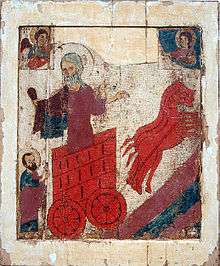
In the New Testament, Jesus would say for those who believed, John the Baptist was Elijah, who would come before the "great and terrible day" as predicted by Malachi.
Some English translations of the New Testament use Elias, a Latin form of the name. In the King James Version, "Elias" appears only in the texts translated from Greek.
John the Baptist
John the Baptist preached a message of repentance and baptism. He predicted the day of judgment using imagery similar to that of Malachi. He also preached that the Messiah was coming. All of this was done in a style that immediately recalled the image of Elijah to his audience. He wore a coat of camel's hair secured with a leather girdle (Matthew 3:4, Mark 1:6). He also frequently preached in wilderness areas near the Jordan River.
In the Gospel of John, when John the Baptist was asked by a delegation of priests (present tense) "Art thou Elias", he replied "I am not" (John 1:21). Matthew 11:14 and Matthew 17:10–13 however, make it clear that John was the spiritual successor to Elijah. In the Nativity of St. John the Baptist in Luke, Gabriel appears to Zechariah, John's father, and told him that John "will turn many of the sons of Israel to the Lord their God," and that he will go forth "in the spirit and power of Elijah" (Luke 1:16–17).
Jesus Christ
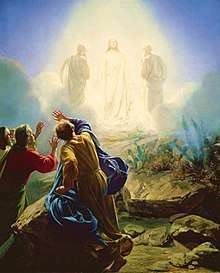
In the Gospel of Luke, Herod Antipas hears some of the stories surrounding Jesus Christ. Some tell Herod that Jesus is John the Baptist (whom Herod had executed) come back to life. Others tell him that Jesus is Elijah.[78] Later in the same gospel, Jesus asks his disciples who the people say that he is. The apostles' answer includes Elijah among others.[79]
However Jesus' ministry had little in common with that of Elijah; in particular, he preached the forgiveness of one's enemies, while Elijah killed his. Miracle stories similar to those of Elijah were associated with Jesus (e.g., raising of the dead,[80] miraculous feeding).[81] Jesus implicitly separates himself from Elijah when he rebukes James and John for desiring to call down fire upon an unwelcoming Samaritan village in a similar manner to Elijah.[82] Likewise, Jesus rebukes a potential follower who wanted first to return home to say farewell to his family, whereas Elijah permitted this of his replacement Elisha.[83]
During Jesus' crucifixion, some of the onlookers wonder if Elijah will come to rescue him,[84] as by the time of Jesus, Elijah had entered folklore as a rescuer of Jews in distress.
Transfiguration
Elijah makes an appearance in the New Testament during an incident known as the Transfiguration.[85]
At the summit of an unnamed mount, Jesus' face begins to shine. The disciples who are with Him hear the voice of God announce that Jesus is "My beloved Son." The disciples also see Moses and Elijah appear and talk with Jesus. This apparently relates to how both Elijah and Moses, the latter according to tradition but not the Bible, both were translated to heaven instead of dying. Peter is so struck by the experience that he asks Jesus if they should build three "tabernacles": one for Elijah, one for Jesus and one for Moses.
There is agreement among some Christian theologians that Elijah appears to hand over the responsibility of the prophets to Jesus as the woman by the well said to Jesus (John 4:19) "I perceive thou art a prophet." Moses also likewise came to hand over the responsibility of the law for the divinely announced Son of God.[86][87]
Other references
Elijah is mentioned four more times in the New Testament: in Luke, Romans, Hebrews, and James. In Luke 4:24–27, Jesus uses Elijah as an example of rejected prophets. Jesus says, "No prophet is accepted in his own country," and then mentions Elijah, saying that there were many widows in Israel, but Elijah was sent to one in Phoenicia. In Romans 11:1–6, Paul cites Elijah as an example of God's never forsaking his people (the Israelites). Hebrews 11:35 ("Women received their dead raised to life again...") refers to both Elijah raising the son of the widow of Zarephath and Elisha raising the son of the woman of Shunem, citing both Elijah and Elisha as Old Testament examples of faith.[88][89][90] In James 5:16–18, James says, "The effectual fervent prayer of a righteous man availeth much," and then cites Elijah's prayers which started and ended the famine in Israel as examples.
Prophet saint
In Western Christianity, the Prophet Elijah is commemorated as a saint with a feast day on 20 July by the Roman Catholic Church[91] and the Lutheran Church–Missouri Synod.[92] Catholics believe that he was unmarried and celibate.[93]
In the Eastern Orthodox Church and those Eastern Catholic Churches which follow the Byzantine Rite, he is commemorated on the same date (in the 21st century, Julian Calendar 20 July corresponds to Gregorian Calendar 2 August). He is greatly revered among the Orthodox as a model of the contemplative life. He is also commemorated on the Orthodox liturgical calendar on the Sunday of the Holy Fathers (the Sunday before the Nativity of the Lord).
Elijah has been venerated as the patron saint of Bosnia and Herzegovina since 26 August 1752, replacing George of Lydda at the request of Bishop Pavao Dragičević. The reasons for the replacement are unclear. It has been suggested that Elijah was chosen because of his importance to all three main religious groups in Bosnia and Herzegovina—Catholics, Muslims and Orthodox Christians.[94] Pope Benedict XIV is said to have approved Bishop Dragičević's request with the remark that a wild nation deserved a wild patron.[95]
Carmelite tradition
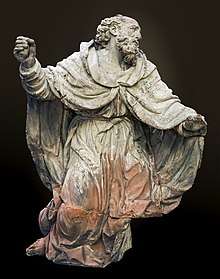
Elijah is revered as the spiritual Father and traditional founder of the Catholic religious Order of Carmelites. In addition to taking their name from Mt. Carmel where the first hermits of the order established themselves, the Calced Carmelite and Discalced Carmelite traditions pertaining to Elijah focus upon the prophet's withdrawal from public life.[96][97] The medieval Carmelite Book of the First Monks offers some insight into the heart of the Orders' contemplative vocation and reverence for the prophet.
In the 17th century the Bollandist Society, whose declared aim was to search out and classify materials concerning the saints venerated by the Church, and to print what seemed to be the most reliable sources of information [98] entered into controversy with the Carmelites on this point. In writing of St. Albert, Patriarch of Jerusalem and author of the Carmelite rule, the Bollandist Daniel Papebroch stated that the attribution of Carmelite origin to Elijah was insufficiently grounded. The Carmelites reacted strongly. From 1681 to 1698 a series of letters, pamphlets and other documents was issued by each side. The Carmelites were supported by a Spanish tribunal, while the Bollandists had the support of Jean de Launoy and the Sorbonne. In November 1698, Pope Innocent XII ordered an end to the controversy.[99]
Liturgical commemorations
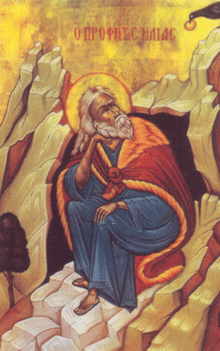
Since most Eastern Churches either use Greek as their liturgical language or translated their liturgies from the Greek, Elias (or its modern iotacized form Ilias) is the form of the prophet's name used among most members of the Eastern Orthodox Church and those Eastern Catholic Churches which follow the Byzantine Rite.
The feast day of saint Elias falls on July 20 of the Orthodox liturgical calendar (for those churches which follow the traditional Julian Calendar, July 20 currently falls on August 2 of the modern Gregorian Calendar). This day is a major holiday in Lebanon and is one of a handful of holidays there whose celebration is accompanied by a launching of fireworks by the general public. The full name of St. Elias in Lebanon translates to St. Elias the Living because it is believed that he did not die but rode his fiery chariot to heaven. The reference to the fiery chariot is likely why the Lebanese celebrate this holiday with fireworks.
Elias is also commemorated, together with all of the righteous persons of the Old Testament, on the Sunday of the Holy Fathers (the Sunday before the Nativity of the Lord).
The Apolytikion in the Fourth Tone for St. Elias:
The incarnate Angel, the Cornerstone of the Prophets, the second Forerunner of the Coming of Christ, the glorious Elias, who from above, sent down to Elisha the grace to dispel sickness and cleanse lepers, abounds therefore in healing for those who honor him.
The Kontakion in the Second Tone for St. Elias:
O Prophet and foreseer of the great works of God, O greatly renowned Elias, who by your word held back the clouds of rain, intercede for us to the only Loving One.
Pagan associations and mountaintops
Starting in the fifth century, Elias is often connected with Helios, the Sun. The two words have very similar pronunciations in post-classical Greek; Elijah rode in his chariot of fire to heaven (2 Kings 2:11) just as Helios drove the chariot of the sun across the sky; and the holocaust sacrifice offered by Elijah and burned by fire from heaven (1 Kings 18:38) corresponds to the sun warming the earth.[100]
Sedulius writes poetically in the fifth century that the "bright path to glittering heaven" suits Elias both "in merits and name", as changing one letter makes his name "Helios"; but he does not identify the two.[101] A homily entitled De ascensione Heliae, misattributed to Chrysostom, claims that poets and painters use the ascension of Elijah as a model for their depictions of the sun, and says that "Elijah is really Helios". Saint Patrick appears to conflate Helios and Elias.[102] In modern times, much Greek folklore also connects Elias with the sun.[103]
In Greece, chapels and monasteries dedicated to Prophet Elias (Προφήτης Ηλίας) are often found on mountaintops, which themselves are often named after him. Since Wachsmuth (1864),[104] the usual explanation for this has been that Elias was identified with Helios, who had mountaintop shrines. But few shrines of Helios were on mountaintops, and sun-worship was subsumed by Apollo-worship by Christian times, and so could not be confused with Elias.[105] The modern folklore is not good evidence for the origin of the association of the sun, Elias, and mountaintops.[106] Perhaps Elias is simply a "natural patron of high places".[107]
The association of Elias with mountaintops seems to come from a different pagan tradition: Elias took on the attributes and the locales associated with Zeus, especially his associations with mountains and his powers over rain, thunder, lighting, and wind. When Elias prevailed over the priests of Baal, it was on Mount Carmel (1 Kings 18:38), which later became known as Mount St. Elias. When he spent forty days in a cave, it was on Mount Horeb (1 Kings 19:8). When Elias confronted Ahab, he stopped the rains for three years (1 Kings 17:1-18:1).[106]
A map of mountain-cults of Zeus shows that most of these sites are now dedicated to Elias, including Mount Olympus, Mount Lykaion, Mount Arachnaion, and Mount Taleton on the mainland, and Mount Kenaion, Mount Oche, and Mount Kynados in the islands. Of these, the only one with a recorded tradition of a Helios cult is Mount Taleton.[106]
Elias is associated with pre-Christian lightning gods in many other European traditions.
Among Albanians, pilgrimages are made to mountaintops to ask for rain during the summer. One such tradition that is gaining popularity is the 2 August pilgrimage to Ljuboten on the Sharr mountains. Muslims refer to this day as Aligjyn ("Ali Day"), and it is believed that Ali becomes Elias at midday.[108]
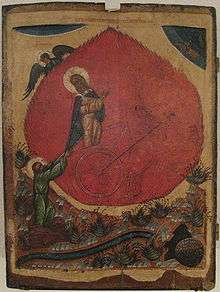
As Elijah was described as ascending into heaven in a fiery chariot, the Christian missionaries who converted Slavic tribes likely found him an ideal analogy for Perun, the supreme Slavic god of storms, thunder and lightning bolts. In many Slavic countries Elijah is known as Elijah the Thunderer (Ilija Gromovnik), who drives the heavens in a chariot and administers rain and snow, thus actually taking the place of Perun in popular beliefs.[109][110][111] Perun is also sometimes conflated with the legendary hero Elijah of Murom.[112][113] The feast of St. Elias is known as Ilinden in South Slavic, and was chosen as the day of the Ilinden-Preobrazhenie Uprising in 1903; it is now the holiday of Republic Day in North Macedonia.
In Estonian folklore Elijah is considered to be the successor of Ukko, the lightning spirit.[113]
In Georgian mythology, he replaces Elwa.[113] A Georgian story about Elijah:
Once Jesus, the prophet Elijah, and St. George were going through Georgia. When they became tired and hungry they stopped to dine. They saw a Georgian shepherd and decided to ask him to feed them. First, Elijah went up to the shepherd and asked him for a sheep. After the shepherd asked his identity Elijah said that, he was the one who sent him rain to get him a good profit from farming. The shepherd became angry at him and told him that he was the one who also sent thunderstorms, which destroyed the farms of poor widows. (After Elijah, Jesus and St. George attempt to get help and eventually succeed).[114]
Elias has other pagan associations: a modern legend about Elias mirrors precisely the legend of Odysseus seeking a place where the locals would not recognize an oar—hence the mountaintops.[115]
Elijah and Elias in The Church of Jesus Christ of Latter-day Saints
The Church of Jesus Christ of Latter-day Saints acknowledges Elijah as a prophet. The Church teaches that the Malachi prophecy of the return of Elijah was fulfilled on April 3, 1836, when Elijah visited the prophet and founder of the church, Joseph Smith, along with Oliver Cowdery, in the Kirtland Temple as a resurrected being.[116] This event is chronicled in Doctrine and Covenants 110:13–16. This experience forms the basis for the church's focus on genealogy and family history and belief in the eternal nature of marriage and families.
In Latter-day Saint theology, the name-title Elias is not always synonymous with Elijah and is often used for people other than the biblical prophet.[117] According to Joseph Smith,
The spirit of Elias is first, Elijah second, and Messiah last. Elias is a forerunner to prepare the way, and the spirit and power of Elijah is to come after, holding the keys of power, building the Temple to the capstone, placing the seals of the Melchizedek Priesthood upon the house of Israel, and making all things ready; then Messiah comes to His Temple, which is last of all.[118]
People to whom the title Elias is applied in Mormonism include Noah, the angel Gabriel (who is considered to be the same person as Noah in Mormon doctrine), Elijah, John the Baptist, John the Apostle, and an unspecified man who was a contemporary of Abraham.[119]
Detractors of Mormonism have often alleged that Smith, in whose time and place the King James Version was the only available English translation of the Bible, simply failed to grasp the fact that the Elijah of the Old Testament and the Elias of the New Testament are the same person.[120] Latter-day Saints deny this and say that the difference they make between the two is deliberate and prophetic. The names Elias and Elijah refer to one who prepares the way for the coming of the Lord. This is applicable to John the Baptist coming to prepare the way for the Lord and His baptism; it also refers to Elijah appearing during the transfiguration to prepare for Jesus by restoring keys of sealing power.[120] Jesus then gave this power to the Twelve saying, "Verily I say unto you, Whatsoever ye shall bind on earth shall be bound in heaven: and whatsoever ye shall loose on earth shall be loosed in heaven." [121]
Elijah in Islam
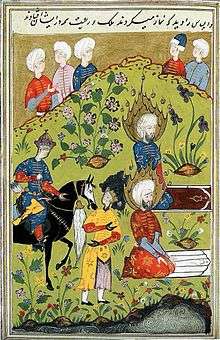
Part of a series on Islam Islamic prophets |
|---|
 |
|
Listed by Islamic name and Biblical name.
|
|
|
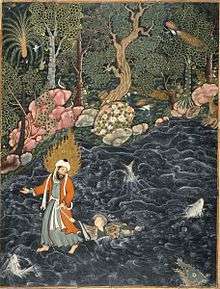
Elijah (Arabic: إلياس or إليا; Ilyas or Ilya) is also mentioned as a prophet in the Qur'an, al-An'am 85. Elijah's narrative in the Qur'an and later Muslim tradition resembles closely that in the Hebrew Bible and Muslim literature records Elijah's primary prophesying as taking place during the reign of Ahab and Jezebel as well as Ahaziah.[lower-alpha 3] He is seen by Muslims to be the prophetic predecessor to Elisha. While neither the Bible nor the Qur'an mentions the genealogy of Elijah, some scholars of Islam believe he may have come from the priestly family of the prophet Aaron.[123] Elijah is rarely associated with Islamic eschatology and Islam views Jesus as the Messiah.[124] However, Elijah is expected to come back along with the mysterious figure known as Khidr during the Last Judgment.[125] Elijah's figure has been identified with a number of other prophets and saints, including Idris, which is believed by some scholars to have been another name for Elijah,[126] and Khidr.[127] Islamic legend later developed the figure of Elijah, greatly embellishing upon his attributes, and some apocryphal literature gave Elijah the status of a half-human, half-angel.[128] Elijah also appears in later works of literature, including the Hamzanama.[129]
Quran
Elijah is mentioned in the Quran, where his preaching is recounted in a concise manner. The Quran narrates that Elijah told his people to come to the worship of God and to leave the worship of Baal, the primary idol of the area. The Quran states, "Verily Elijah was one of the apostles. When he said to his people: "Will you not fear God? "Will ye call upon Ba'al and leave the Best of Creators, God, your LORD and Cherisher and the LORD and Cherisher of your fathers of old?" As-Saaffat 123–126[130]
The Quran makes it clear that the majority of Elijah's people denied the prophet and continued to follow idolatry. However, it mentions that a small number of devoted servants of God among them followed Elijah and believed in and worshiped God. The Quran states, "They denied him (Elijah), and will surely be brought to punishment, Except the sincere and devoted Servants of God (among them). And We left his (memory) for posterity." As-Saaffat 127–128[131]
In the Quran, God praises Elijah in two places:
Peace be upon Elijah! This is how We reward those who do good. He is truly among our believing servants.
And Zachariah and John and Jesus and Elijah, they were all from among the righteous
Numerous commentators, including Abdullah Yusuf Ali, have offered commentary on VI: 85 saying that Elijah, Zechariah, John the Baptist and Jesus were all spiritually connected. Abdullah Yusuf Ali says, "The third group consists not of men of action, but Preachers of Truth, who led solitary lives. Their epithet is: "the Righteous." They form a connected group round Jesus. Zachariah was the father of John the Baptist, who is referenced as "Elias, which was for to come" (Matt 11:14); and Elias is said to have been present and talked to Jesus at the Transfiguration on the Mount (Matt. 17:3)."[134]
Literature and tradition
Muslim literature and tradition recounts that Elijah preached to the Kingdom of Israel, ruled over by Ahab and later his son Ahaziah. He is believed to have been a "prophet of the desert—like John the Baptist".[135] Elijah is believed to have preached with zeal to Ahab and his wife Jezebel, who according to Muslim tradition was partly responsible for the worship of false idols in this area. Muslims believe that it was because the majority of people refused to listen to Elijah that Elisha had to continue preaching the message of God to Israel after him.[136]
Elijah has been the subject of legends and folktales in Muslim culture, usually involving his meeting with Khidr, and in one legend, with Muhammad himself.[137] In Islamic mysticism, Elijah is associated closely with the sage Khidr. One hadith reported that Elijah and Khidr met together every year in Jerusalem to go on the pilgrimage to Mecca.[138] Elijah appears also in the Hamzanama numerous times, where he is spoken of as being the brother of Khidr as well as one who drank from the Fountain of Youth.[139]
Further, It is narrated in Kitab al-Kafi that Imam Ja'far al-Sadiq was reciting the prostration of Ilyas (Elijah) in the Syrian language and began to weep. He then translated the supplication in Arabic to a group of visiting scholars:
"O Lord, will I find that you punish me although you know of my thirst in the heat of midday? Will I find that you punish me although you know that I rub my face on Earth to worship you? Will I find that you punish me although you know that I give up sins for you? Will I find that you punish me although you know that I stay awake all night just for you?" To which Allah then inspired to Ilyas, "Raise your head from the Earth for I will not punish you".[140]
Although most Muslim scholars believed that Elijah preached in Israel, some early commentators on the Qur'an stated that Elijah was sent to Baalbek, in Lebanon.[141] Modern scholars have rejected this claim, stating that the connection of the city with Elijah would have been made because of the first half of the city's name, that of Baal, which was the deity that Elijah exhorted his people to stop worshiping. Scholars who reject identification of Elijah's town with Baalbek further argue that the town of Baalbek is not mentioned with the narrative of Elijah in either the Qur'an or the Hebrew Bible.[142]
Elijah in the Bahá'i Faith
In the Bahá'í Faith, the Báb, founder of the Bábí Faith, is believed to be the return of Elijah and John the Baptist.[143] Both Elijah and John the Baptist are considered to be Lesser Prophets, whose stations are below that of a Manifestation of God like Jesus Christ, Buddha, the Báb or Bahá'u'lláh. The Báb is buried on Mount Carmel, where Elijah had his confrontation with the prophets of Baal.[144]
Controversies
Miracle of the ravens
Elijah fed by the ravens, by Giovanni Lanfranco, Musée des beaux-arts de MarseilleThat ravens fed Elijah by the brook Chorath has been questioned. The Hebrew text at 1 Kings 17:4–6 uses the word עֹרְבִים `ōrvīm, which means ravens, but with a different vocalization might equally mean Arabs. The Septuagint has κορακες, ravens, and other traditional translations followed.
Alternatives have been proposed for many years; for example Adam Clarke (d. 1832) treated it as a discussion already of long standing.[145] Objections to the traditional translation are that ravens are ritually unclean (see Leviticus 11:13–17) as well as physically dirty; it is difficult to imagine any method of delivery of the food which is not disgusting. The parallelism with the incident that follows, where Elijah is fed by the widow, also suggests a human, if mildly improbable, agent.
Prof. John Gray chooses Arabs, saying "We adopt this reading solely because of its congruity with the sequel, where Elijah is fed by an alien Phoenician woman."[146] His translation of the verses in question is:
And the word of Jehovah came to Elijah saying, Go hence and turn eastward and hide thyself in the Wadi Chorath east of the Jordan, and it shall be that thou shalt drink of the wadi, and I have commanded the Arabs to feed thee there. And he went and did according to the word of Jehovah and went and dwelt in the Wadi Chorath east of the Jordan. And the Arabs brought him bread in the morning and flesh in the evening and he would drink of the wadi.Fire on Mount Carmel
The challenge to the priests of Baal had the two-fold purpose of demonstrating that the God of Israel was greater than Baal, and that it was he who was the giver of rain. According to J. Robinson, "Some scholars have suggested that the pouring of water was a piece of sympathetic magic."[147]
Hugo Gressmann suggested that the fire that destroyed the offering and altar was lightning, while Ferdinand Hitzig and others[148] thought the water poured on the sacrifice and into the ditch might have been flammable naphtha. Baptist scholar H. H. Rowley rejects both views.[149] Robinson dismisses the suggestion of naphtha with the view that the priests of Baal would have been aware of the properties of naphtha.[147] Julian Morgenstern rejects the idea of sympathetic magic, but supports the interpretation of white naphtha possibly ignited by a glass or mirror to focus the sun's rays, citing other mentions of sacred fire, as in 2 Maccabees 1:18–22.[150]
Ascension into the heavens
In the Gospel of John, Jesus says: "And no man hath ascended up to heaven, but he that came down from heaven, [even] the Son of man which is in heaven." (John 3)
Traditionally Christianity interprets the "Son of Man" as a title of Jesus, but this has never been an article of faith and there are other interpretations. Further interpreting this quote, some Christians believe that Elijah was not assumed into heaven but simply transferred to another assignment either in heaven[151] or with King Jehoram of Judah.[151] The prophets reacted in such a way that makes sense if he was carried away, and not simply straight up (2 Kings 2:16).
The question of whether Elijah was in heaven or elsewhere on earth depends partly on the view of the letter Jehoram received from Elijah in 2 Chronicles 21 after Elijah had ascended. Some have suggested that the letter was written before Elijah ascended, but only delivered later.[152] The rabbinical Seder Olam explains that the letter was delivered seven years after his ascension.[153] This is also a possible explanation for some variation in manuscripts of Josephus' Antiquities of the Jews when dealing with this issue.[154] Others have argued that Elijah was only "caught away" such as Philip in Acts 8[lower-alpha 4] John Lightfoot reasoned that it must have been a different Elijah.[156]
Elijah's name typically occurs in Jewish lists of those who have entered heaven alive.
Return
Centuries after his departure the Jewish nation awaits the coming of Elijah to precede the coming of the Messiah. For many Christians this prophecy was fulfilled in the gospels, where he appears during the Transfiguration alongside Moses (Matthew 17:9–13). Commentators have said that Moses' appearance represented the law, while Elijah's appearance represented the prophets.[157] The Church of Jesus Christ of Latter-day Saints believes that Elijah returned on April 3, 1836 in an appearance to Joseph Smith and Oliver Cowdery, fulfilling the prophecy in Malachi.
The Bahá'í Faith believes Elijah returned as the biblical prophet John the Baptist and as the Báb who founded the Bábí Faith in 1844.[158][159]
The Nation of Islam believes Elijah returned as Elijah Muhammad, black separatist religious leader (who claimed to be a "messenger", not a prophet). This is considered less important than their belief that Allah himself showed up in the person of Fard Muhammad, the founder of the group. It differs notably from most beliefs about Elijah, in that his re-appearance is usually the precursor to a greater one's appearance, rather than an afterthought.[160]
Elijah in arts and literature
- Perhaps the best-known representation of the story of Elijah is Felix Mendelssohn's oratorio "Elijah". The oratorio chronicles many episodes of Elijah's life, including his challenge to Ahab and the contest of the gods, the miracle of raising the dead, and his ascension into heaven. Composed and premiered in 1846, the oratorio was criticized by members of the New German School but nonetheless remains one of the most popular Romantic choral-orchestral works in the repertoire.
- In his ethnography Waiting for Elijah: Time and Encounter in a Bosnian Landscape, anthropologist Safet HadžiMuhamedović discusses the syncretic harvest feast of Elijah's Day (Ilindan/Aliđun), shared by Christians and Muslims throughout Bosnia.[161] He focuses on the Field of Gacko in the southeastern Bosnian highlands. Starting with a well-known Bosnian proverb about Elijah's two names "Ilija until noon - Alija after noon" (Do podne Ilija, od podne Alija), HadžiMuhamedović discusses the traditional and postwar waiting for Elijah, as well as the plethora of other characters he merges with (e.g. Slavic deity Perun and prophet Khidr). As the central trope in the book, the waiting for Elijah becomes the waiting for the restoration of home and cosmology after nationalist violence. The absence of Elijah is reminiscent of the one in Jewish rituals and HadžiMuhamedović discovers an imaginative form of political resistance in the waiting for Elijah's return.
- In Orlando Furioso, the English knight Astolfo flies up to the moon in Elijah's flaming chariot.
- Elijah Rock is a traditional Christian spiritual about Elijah, also sometimes used by Jewish youth groups.
- "Go Like Elijah" is a song by the American rock-pop-jazz songwriter Chi Coltrane.
- Lorenzetto created a statue of Elijah with assistance of the young sculptor Raffaello da Montelupo, using designs by Raphael.[162]
- The Fifth Mountain by Paulo Coelho is based on the story of Elijah.
- Christian metal band Disciple released the song "God of Elijah" on their 2001 album By God. The theme of the song is the challenge Elijah placed against Ahab between Baal and the god of Israel.
- The roots-fusion band Seatrain records, on the albums of the same name (1970), band member Peter Rowans song "Waiting for Elijah", alluding to Elijah's second coming.
- From 1974 to 1976 Philip K. Dick believed himself to be possessed by the spirit of Elijah.[163] He later included Elijah (as Elias Tate) in his novel The Divine Invasion.
- On Ryan Adams' 2005 album 29, the song "Voices" speaks of Elijah, alluding to Elijah being the prophet of destruction.
- Journeys With Elijah: Eight Tales of the Prophet, book by Barbara Goldin and illustrated by Jerry Pinkney
- In 1996, Robin Mark created a praise song entitled Days of Elijah.
- Cormac McCarthy's post-apocalyptic novel The Road (2006) features an old man who ambiguously refers to himself as Ely.
- Elijah ("Lije") is the name of the protagonist in three novels of Isaac Asimov's Robot series. He is familiar with biblical stories and sometimes relates them in the narrative or in discussion with his robot partner who was built on a world devoid of religion. His wife is ironically named Jezebel.
- The popular movie Chariots of Fire alludes to the William Blake poem And did those feet in ancient time, which in turn alludes to the Elijah story.
- Elijah was played by John Hoyt in the 1953 film Sins of Jezebel.
- A series of paintings by Clive Hicks-Jenkins around 2003–07 depicted Elijah being fed by a raven, inspired by fragments of a Tuscan altarpiece in Christ Church Picture Gallery in Oxford.[164]
- Referenced in the song "It Was Written", by Damian Marley, featuring Capleton and Drag-On.
- Referenced in the movie The Book of Eli, starring Denzel Washington in the title role as the man on a mission in a post-apocalyptic world to deliver the Bible for safe-keeping.
- I. L. Peretz wrote The Magician, which was illustrated by Marc Chagall in 1917, about Elijah.[165]
- Early in Moby-Dick, Ishmael and Queequeg run into a scarred and deformed man named Elijah, a prophet (or perhaps merely a frightening stranger) who hints to them the perils of signing aboard Ahab's ship, the Pequod.
- Elijah appears in psychologist Carl Jung's "Red Book" as one of central book heroes.
See also
- Biblical narratives and the Qur'an
- Carmelites
- Eli (name)
- Elias
- Elisha
- Entering Heaven alive
- Khidr
- Legends and the Qur'an
- Prophets of Islam
- Stories of The Prophets
- St. Elijah's Church (disambiguation), for churches dedicated to Elijah
- Theophoric name
- Two witnesses
Notes
- Greek: Ἡλίας, Elías; Syriac: ܐܸܠܝܼܵܐ, Elyāe; Arabic: إلياس or إليا, Ilyās or Ilyā.
- Psalm 45, sometimes viewed as a wedding song for Ahab and Jezebel, may allude to this union and its problems: "Hear, Oh daughter, consider, and incline your ear; forget your people and your father's house; and the king will desire your beauty. Since he is your lord, bow to him; the people of Tyre will sue your favor with gifts." Psalms 45:10–12 See: Smith (1982)[20]
- "Elias is the same as Elijah, whose story will be found in the Old Testament in 1 Kings 17–19 and 2 Kings 1–2. Elijah lived in the reign of Ahab (896–874 BC) and Ahaziah (874–872 BC), kings of the (northern) kingdom of Israel or Samaria. He was a prophet of the desert, like John the Baptist, unlike our holy Prophet, who took part in, controlled, and guided all the affairs of his people. Both Ahab and Azariah were prone to lapse into the worship of Baal, the sun-god worshipped in Syria. That worship also included the worship of nature-powers and procreative powers, as in the Hindu worship of the Lingam, and led to many abuses. King Ahab had married a princess of Sidon, Jezebel, a wicked woman who led her husband to forsake Allah and adopt Baal-worship." ... "Elijah denounced all Ahab's sins as well as the sins of Ahaziah and had to flee for his life. Eventually, according to the Old Testament (4 Kings, 2:11) he was taken up in a whirlwind to heaven in a chariot of fire after he had left his mantle with Elisha the prophet."[122]
- "There is evidence that Elijah was back on earth after he was taken away in the whirlwind: It can be shown that a letter was received by Jehoram, King of Judah, from Elijah, after Elijah was taken to heaven. Either the letter was written before he went to heaven and delivered by a messenger on earth (unlikely), or Elijah was "caught away" as was Philip from the Gaza Road to Azotas, (about 17 miles, Acts 8) for an unspecified purpose and returned to the earth. Consider the evidence:
1. Elijah had been taken to heaven in a whirlwind. (2 Kings 2).
2. Elisha had taken over the duties of Elijah in the reign of Jehoshaphat. (2 Kings 3).
3. Jehoram received a letter from Elijah, the prophet. (2 Chron 21). King Jehoram reigned after Jehoshaphat. (2 Chron 21)".[155]References
- Cline, Austin. "Biography of Elijah, Old Testament Prophet". Retrieved 17 July 2020.
- "St. Elijah the Prophet". Retrieved 17 July 2020.
- "The Glorious Prophet Elias (Elijah)". Retrieved 17 July 2020.
- Calendar of Saints (Lutheran)
- "St. Elijah the Prophet". Retrieved 17 July 2020.
- Coogan, Michael David (2006). The Old Testament: A Historical and Literary Introduction to the Hebrew Scriptures. Oxford, England: Oxford University Press. p. 304. ISBN 9780195139105.
- Sperling, S. David (2007). "Elijah". In Skolnik, Fred (ed.). Encyclopaedia Judaica. 6 (2 ed.). Thomson Gale. p. 331. ISBN 978-0-02-865934-3.
- Barton, John; Muddiman, John (2007). The Oxford Bible Commentary. Oxford, England: Oxford University Press. p. 246. ISBN 9780199277186. entry "Elijah"
- Yonge, Charlotte Mary (1859). "The Kingdom of Samaria". The Chosen People (5th ed.).
- 2 Kings 2:11
- 2 Kings 2:3
- Malachi 4:5
- Matthew 16:14 & Mark 8:28.
- For John the Baptist as Elijah, see Luke 1:11–17 & Matthew 11:14;17:10–13.
- Tottoli, Roberto (2002). "Elijah". In Jane Dammen McAuliffe (ed.). Encyclopaedia of the Qurʾān. Two. Boston: Brill. pp. 12–13.
- "Sveti Ilija - zaštitnik Bosne i Hercegovine" (in Croatian). vecernji.ba. 21 July 2012. Retrieved 2 July 2013.
- "The Peraea and the Dead Sea". The Madaba Mosaic Map. Archived from the original on 27 July 2011. Retrieved 13 October 2014.
- Kaufman, Yehezkel (1956). "The Biblical Age". In Schwarz, Leo W. (ed.). Great Ages and Ideas of the Jewish People. New York, NY: Modern Library. pp. 53–56.
- Raven, John H. (1979). The History of the Religion of Israel. Grand Rapids, MI: Baker Book House. pp. 281–281.
- Smith, Norman H. (1982). "I Kings". In Buttrick, George A.; et al. (eds.). The Interpreter's Bible. 3. Nashville, TN: Abingdon Press. p. 144.
- Miller, J.M.; Hayes, J.H. (2006). A History of Ancient Israel and Judah. Louisville, KY: Westminster John Knox Press.
- New Bible Dictionary (second ed.). Wheaton, IL, US: Tyndale Press. 1982. p. 323. ISBN 0-8423-4667-8.
Hirsch, Emil G.; König, Eduard; Schechter, Solomon; Ginzberg, Louis; Seligsohn, M.; Kohler, Kaufmann (1903). "Elijah". In Singer, Isidore; et al. (eds.). The Jewish Encyclopedia. V. New York: Funk & Wagnalls. - "Elijah". Encyclopaedia Judaica. Jerusalam: Keter Publishing House. 1971. p. 633.
- Cogan, Mordechai. The Anchor Bible: I Kings. New York: Doubleday, 2001. p. 425.
- Werblowsky, R.J.Z.; Wigoder, Geoffrey, eds. (1997). Oxford Dictionary of the Jewish Religion. Oxford, UK: Oxford University Press. ISBN 0-19-508605-8.
- 1 Kings 18:17-19
- 1 Kings 17
- 1 Kings 17:13,14 New Revised Standard Version
- 1 Kings 17:18 New Revised Standard Version.
- 1 Kings 17:22 New Revised Standard Version
- 1 Kings 17:24 New Revised Standard Version.
- 1 Kings 18:21
- 1 Kings 18:27
- 1 Kings 18:33–34
- 1 Kings 19:1–13
- Smith, William Robertson; Cook, Stanley Arthur (1911). . In Chisholm, Hugh (ed.). Encyclopædia Britannica. 9 (11th ed.). Cambridge University Press. pp. 273–274.
- 1 Kings 19:9
- 1 Kings 21:19 New Revised Standard Version
- 2 Kings 1:6
- 2 Kings 1:17
- 2 Kings 2:8
- Myers, J. M. The Anchor Bible: II Chronicles. Garden City, NY: Doubleday and Company, 1965. pp. 121–23.
- VanSeters, John. "Elijah." In Jones, Lindsay. Editor in Chief. Encyclopedia of Religion. Farmington Hills, MI: Thomson Gale, 2005. p. 2764.
- IVP New Bible Commentary 21st Century Edition, p. 410.
- "Jewish and Christian Bibles: Comparative Chart". catholic-resources.org.
- Malachi 4:5, New Revised Standard Version
- Malachi 4:1
- Matthew 11:14
- Otto, Susanne (2003-06-01). "Susanne Otto, "The Composition of the Elijah-Elisha Stories and the Deuteronomistic History"". Journal for the Study of the Old Testament. 27 (4): 487–508. Retrieved 2014-03-05.(Online Abstract)
- Midrash Genensis Rabbah lxxi.
- Aphraates, "Homilies," ed. Wright, p. 314; Epiphanius, "Hæres." lv. 3, passim
- Pirḳe R. El. xlvii.; Targ. Yer. on Num. xxv. 12
- Yalḳuṭ Reubeni, Bereshit, 9a, ed. Amsterdam
- Baba Metzia 14B
- Pirḳe R. El. xxix.
- Tanna debe Eliyahu Zuṭa viii.
- Tan., Peḳude, p. 128, Vienna ed.
- Seder 'Olam R. xvii.
- Ḳid. 70; Ber. R. xxxiv. 8
- Suk. 5a
- Compare Pirḳe R. El. xvi.
- "Elijah, Chair of." Encyclopaedia Judaica. Jerusalem: Keter Publishing House, 1971.
- Unterman, Alan. "Elijah's Chair." Dictionary of Jewish Lore and Legend. London: Thames and Hudson, 1991.
- "Elijah, Cup of." Encyclopaedia Judaica. Jerusalem: Keter Publishing House, 1971.
- Telushkin, Joseph. Jewish Literacy. New York: William Morrow, 2001.
- "Rabbi Ario S. and Tess Hyams Judaica Museum". Temple Beth Sholom. 2007. Archived from the original on 2007-07-23. Retrieved 2007-06-23.
- Ginzberg, Lewis. Legends of the Bible. Philadelphia: Jewish Publication Society of America, 1956. p. 580.
- Ginzberg, Lewis. Legends of the Bible. Jewish Philadelphia: Publication Society of America, 1956. p. 589
- Ginzberg, Lewis. Legends of the Bible. Philadelphia: Jewish Publication Society of America, 1956. pp. 590–91.
- Schwartz, Howard. Tree of Souls: The Mythology of Judaism. Oxford: Oxford University Press, 2004. p. 201.
- Bialik, H. N. and Y. H Ravnitzky. eds. The Book of Legends: Sefer Ha-Aggadah. New York: Schocken Books, 1992. pp. 756, 782, 805.
- Ginzberg, Lewis. Legends of the Bible. Philadelphia: Jewish Publication Society of America, 1956. p. 599.
- Ginzberg, Lewis. Legends of the Bible. Philadelphia: Jewish Publication Society of America, 1956. p. 597.
- Schwartz, Howard. Tree of Souls: The Mythology of Judaism. Oxford: Oxford University Press, 2004.
- Ginzberg, Lewis. Legends of the Bible. Philadelphia: Jewish Publication Society of America, 1956.
- Schwartz, Howard. Tree of Souls: The Mythology of Judaism. Oxford: Oxford University Press, 2004. pp. 224–25.
- Luke 9:7–9 also Mark 6:14–16
- Luke 9:18–19, also Matthew 16:13–16
- Mark 5:21–43, Luke 7:11–15, Luke 8:49–56, John 11
- Matthew 14:13–21, Mark 6:34–45, Luke 9:10–17, John 6:5–16; also Matthew 15:29–38 and Mark 8:1–9
- Luke 9:51–56
- Luke 9:61–62, 1 Kings 19:16–21
- Matthew 27:46–49, Mark 15:35–36
- Matthew 17:1–13, Mark 9:2–13 and Luke 9:28–36
- Albright, W. F. and C. S. Mann. The Anchor Bible: Matthew. New York: Doubleday, 1971.
- Fitzmyer, Joseph A. The Anchor Bible: Luke I–IX. New York: Doubleday, 1981.
- Gill, John. "Hebrews 11:35". biblestudytools.com. Retrieved 2015-09-25.
- Henry, Matthew. "Hebrews 11". biblestudytools.com. Retrieved 2015-09-25.
- Brown, Robert Jamieson, A. R. Fausset and David. "Hebrews 11". biblestudytools.com. Retrieved 2015-09-25.
- Martyrologium Romanum (Libreria Editrice Vaticana 2001 ISBN 88-209-7210-7)
- Calendar of Saints (Lutheran)
- "Why are Priests Celibate?". Holy Spirit Interactive. 2010-08-19. Archived from the original on 2011-07-23.
- Skoko, Iko (21 August 2012). "Sveti Ilija – zaštitnik Bosne i Hercegovine" (in Serbo-Croatian). Večernji list.CS1 maint: ref=harv (link)
- Martić, Zvonko (2014). "Sveti Jure i sveti Ilija u pučkoj pobožnosti katolika u Bosni i Hercegovini" (in Serbo-Croatian). Svjetlo riječi. Archived from the original on 2016-08-22. Retrieved 2016-08-06.CS1 maint: ref=harv (link)
- Ackerman, Jane. "Stories of Elijah and medieval Carmelite identity." History of Religions. 35(2). 1995. 124–47.
- Ackerman, Jane. Elijah Prophet of Carmel. Washington, D.C.: Institute of Carmelite Studies Publications, 2003.
- "Thurston, Herbert. "The Bollandists and Their Work", The Tablet, July 27, 1907". Archived from the original on March 31, 2016. Retrieved April 16, 2017.
- "Controversies with Other Orders", The Order of Our Lady of Mount Carmel"
- J. Theodore Bent, "The Sun Myths of Modern Hellas", The Antiquary 20 (1889), p. 10
- Patrick McBrine, translator, Sedulius' Carmen paschale, lines 184–187 PDF Archived 2011-07-15 at the Wayback Machine
- K. Sarah-Jane Murray, From Plato to Lancelot: a preface to Chrétien de Troyes, Syracuse 2008, p. 148 Google Books
- Mary Hamilton, "The Pagan Element in the Names of Saints", Annual of the British School at Athens 13: 348–56 (1907) Google Books
- C. Wachsmuth, Das alte Griechenland im neuen, 1864, p. 23, cited by Hippolyte Delehaye, The Legends of the Saints: An Introduction to Hagiography, 1907, p. 174
- Delehaye, p. 174
- Arthur Bernard Cook, Zeus: A Study in Ancient Religion, 1925, p. 178 Google Books
- F. Lenormant, Monographie de la voie sacrée Éleusinienne, 1864, p. 452 as quoted by Delehaye, p. 174
- Elsie, Robert (2001). A Dictionary of Albanian Religion, Mythology, and Folk Culture. NYU Press. p. 7. ISBN 978-0814722145.
- Lenhoff, Gail. "Christian and Pagan Strata in the East Slavic Cult of St. Nicholas: Polemical Notes on Boris Uspenskij's FilologiÄeskie Razyskanija v Oblasti Slavjanskix Drevnostej." The Slavic and East European Journal. (July 1984) 28.2 pp. 147–63.
- McLeish, Kenneth. Myth: Myths and Legends of the World Explored. London: Facts on File, 1996. p. 506.
- Cherry Gilchrist, Russian Magic: Living Folk Traditions of an Enchanted Landscape, ISBN 0-8356-0874-3, pp. 81ff full text
- Mike Dixon-Kennedy, Encyclopedia of Russian and Slavic myth and legend, ISBN 1-57607-130-8, p. 218, full text
- Merriam-Webster's encyclopedia of world religions, ISBN 0-87779-044-2, s.v. "Slavic religion" full text
- Gabidzashvili, Enriko. 1991. Saint George: In Ancient Georgian Literature. Armazi – 89: Tbilisi, Georgia.
- Arthur Bernard Cook, Zeus: A Study in Ancient Religion, p. 171
- Petersen, Mark E. (August 1981), "The Mission of Elijah", Ensign
- Perkins, Keith W. (July 1999), "I Have a Question: How can Elias, who appeared with Moses on the Mount of Transfiguration, be identified as both the Old Testament prophet Elijah and as John the Baptist?", Ensign
- Smith, Joseph, Jr. (1976) [1938]. Smith, Joseph Fielding (ed.). Teachings of the Prophet Joseph Smith. Salt Lake City: Deseret Book. ISBN 978-0-87579-243-9. OCLC 22984603. p. 340
- "Elias", Bible Dictionary, KJV (LDS), LDS Church
- Burton, Theodore M. Burton (May 1974), "The Power of Elijah", Ensign
- Matthew 18:18
- Abdullah Yusuf Ali, The Holy Qur'an: Text, Translation and Commentary, Note 4112
- Ibn Kathir, Stories of the Prophets, p. 474
- C. Glasse. "Elijah". Concise Encyclopedia of Islam
- "Islamic View of the Coming/Return of Jesus". islamicperspectives.com. Archived from the original on 2015-09-23. Retrieved 2015-09-14.
- Message of the Qur'an, M. Asad, Commentary on 19: 56–57
- Dimensions of Islam, F. Schuon, index. Sayyidna Khizr
- Encyclopedia of Islam, Vol. III, H-Iram
- Adventures of Amir Hamza, J. Seyller, p. 240
- Quran 37:123–126
- Quran 37:127–128
- Quran 37:129–132
- Quran 6:85
- Abdullah Yusuf Ali, The Holy Qur'an: Text, Translation and Commentary, Note. 905"
- Abdullah Yusuf Ali, Holy Qur'an: Text, Translation, Commentary, Note on Elijah
- Stories of the Prophets, Ibn Kathir, Stories of Elias and Elisha
- Historical Dictionary of Prophets in Islam and Judaism, B. M. Wheeler, Elijah: "Muslim exegetes report that the prophet Muhammad and a band of followers once met Elijah on a journey outside Mecca. Elijah served the prophet with food from heaven and then left on a cloud heading for the heavens"
- Historical Dictionary of Prophets in Islam and Judaism, B. M. Wheeler, Elijah: "It is reported by Ibn Kathir that every year during the month of Ramadan in Jerusalem, the prophets Elijah and Khidr meet..."
- The Adventures of Amir Hamza, trans. M. A. Farooqi, cf. List of Characters: Ilyas or Prophet Elias
- Al-Kulayni, Abu Ja’far Muhammad ibn Ya’qub (2015). Kitab al-Kafi. South Huntington, NY: The Islamic Seminary Inc. ISBN 9780991430864.
- Stories of the Prophets, Ibn Kathir, Story of Elias and Elisha
- Historical Dictionary of Prophets in Islam, B. M. Wheeler, Baalbek
- Shoghi, Effendi (1944). God Passes By. Wilmette, Illinois, US: Bahá'í Publishing Trust. p. 58. ISBN 978-0-87743-020-9.
- Esslemont, John (1980). Bahá'u'lláh and the New Era. Wilmette, Illinois, US: Bahá'í Publishing Trust. p. 18. ISBN 978-0-87743-160-2.
- Clarke, Adam. The Holy Bible ... with a Commentary and Critical Notes, Volume II, London 1836
- Gray, John. Old Testament Library, I & II Kings, SCM Press, London, 1964
- Robinson, J. and Robinson, Joseph. The First Book of Kings, Cambridge University Press, 1972, p. 212ISBN 9780521097345
- Balkwill, F.H. "the Sacred Fire of Israel", The Twentieth Century, Volume 60, 1906, p. 277
This article incorporates text from this source, which is in the public domain. - Rowley, H.H., "Elijah on Mount Carmel", p. 210 et seq., The John Rylands Library, University of Manchester
- Morgenstern, Julian. The Fire Upon the Altar, Brill Archive, 1963, p. 65
- Coram, James. "The Fate of Enoch and Elijah". biblical studies. Concordant Publishing Concern. Archived from the original on 2013-05-22. Retrieved 2014-05-04.
- Bromiley International Standard Bible Encyclopedia: E–J p. 55
- Aryeh Kaplan The handbook of Jewish thought, Volume 1 1992 p. 116 "This was seven years after Elijah's death; Seder Olam Rabbah 17.25"
- Begg C. Josephus' story of the later monarchy: (AJ 9, 1–10, 185) Section "Elijah's Letter" p.119
- Ron Abel Wrested Scriptures
- Barrett Richard A.F. A synopsis of criticisms upon those passages, Volume 3, Part 1, p. 234 1847 "But our Dr. Lightfoot is of opinion, that it is not meant of that Elijah, who was carried up to heaven, but of another of his name, who sent this letter"
- "Elijah the prophet". lastdays-eschatology.net. Archived from the original on 2014-03-25. Retrieved 2014-03-25.
- "Bahá'í Reference Library – God Passes By". Reference.bahai.org. 2010-12-31. pp. 49–60. Retrieved 5 March 2014.
- "Bahá'í Reference Library – Bahá'u'lláh and the New Era". Reference.bahai.org. 2010-12-31. pp. 15–16. Retrieved 5 March 2014.
- "Debate between NOI member and I". Retrieved 8 February 2017.
I say, we don't call the Honorable Elijah Muhammad a Prophet. We recognize Prophet Muhammad, of 1400 years ago as the Last Prophet of Allah. The Honorable Elijah Muhammad is Allah's Last and Greatest Messenger to we, the Black man and woman in America.- HadžiMuhamedović, S. (2018) Waiting for Elijah: Time and Encounter in a Bosnian Landscape. New York and Oxford: Berghahn Books.
- "Link to on-line biography of Lorenzetto from Vasari's ''Vite''". Efn.org. Archived from the original on 2009-02-22. Retrieved 2014-03-05.
- Rickman, Gregg. Philip K. Dick: The Last Testament. Long Beach, CA: Fragments West/The Valentine Press, 1985.
- Jacqueline Thalmann, 'Windows to Grace' in Simon Callow, Andrew Green, Rex Harley, Clive Hicks-Jenkins, Kathe Koja, Anita Mills, Montserrat Prat, Jacqueline Thalmann, Damian Walford Davies and Marly Youmans, Clive Hicks-Jenkins (2011: Lund Humphries) ISBN 978-1-84822-082-9, pp. 81–97
- "The Magician". World Digital Library. 1917. Retrieved 2013-09-30.
Bibliography
- Elijah: Prophet of Carmel, by Jane Ackerman, ICS Publications, 2003. ISBN 0-935216-30-8
Anthropology
- HadžiMuhamedović, S. Waiting for Elijah: Time and Encounter in a Bosnian Landscape. New York and Oxford: Berghahn Books. ISBN 978-1-78533-856-4
History
- Miller, J. M. and J. H. Hayes. A History of Ancient Israel and Judah. Louisville, KY: Westminster John Knox Press, 2004. ISBN 0-664-22358-3
Folklore and tradition
- Bialik, H. N. and Y. H Ravnitzky. eds. The Book of Legends: Sefer Ha-Aggadah. New York: Schocken Books, 1992. ISBN 0-8052-4113-2
- Ginzberg, Lewis. Legends of the Bible. Philadelphia: Jewish Publication Society of America, 1956.
- Schwartz, Howard. Tree of Souls: The Mythology of Judaism. Oxford: Oxford University Press, 2004. ISBN 0-19-508679-1
- Wolfson, Ron and Joel L. Grishaver. Passover: The Family Guide to Spiritual Celebration. Woodstock, VT: Jewish Lights Publishing, 2003. ISBN 1-58023-174-8
Children's literature
- Aronin, Ben and Shay Rieger. The Secret of the Sabbath Fish. Philadelphia: Jewish Publication Society of America, 1978. ISBN 0-8276-0110-7
- Goldin, Barbara. Journeys with Elijah: Eight Tales of the Prophet. New York: Harcourt Brace, 1999. ISBN 0-15-200445-9
- Jaffe, Nina. The Mysterious Visitor: Stories of the Prophet Elijah. New York: Scholastic Press, 1997. ISBN 0-590-48422-2
- Jaffe, Nina. The Way Meat Loves Salt: A Cinderella Tale from the Jewish Tradition. New York: Holt Publishing, 1998. ISBN 0-8050-4384-5
- Silverman, Erica. Gittel's Hands. Mahwah, NJ: BridgeWater Books, 1996. ISBN 0-8167-3798-3
- Sydelle, Pearl. Elijah's Tears: Stories for the Jewish Holidays. New York: Holt Publishing, 1996. ISBN 0-8050-4627-5
- Thaler, Mike. Elijah, Prophet Sharing: and Other Bible Stories to Tickle Your Soul. Colorado Springs, CO: Faith Kids Publishing, 2000. ISBN 0-7814-3512-9
- Scheck, Joann. The Water That Caught On Fire. St. Louis, Missouri: Concordia Publishing House: ARCH Books, 1969. (59-1159)
References in the Qur'an
- Mission of Elijah: 37:123–126, 37:127–128
- Praise for Elijah: 6:85, 37:129–132
External links
Wikimedia Commons has media related to Elijah (Biblical figure).
Wikiquote has quotations related to: Elijah
- Legends of the Jews by Louis Ginzberg. The legends of Elijah.
- Dictionary of the History of Ideas: Cosmic Voyages - Mentions (in passing) the story of Elijah being carried up to heaven in a flaming chariot as an inspiration for human flight
- Elijah by Rob Bradshaw Extensive dictionary style article.
- LDS Bible Dictionary Entry on Elijah
- Founder Statue in St Peter's Basilica
- Holy, Glorious Prophet Elijah Orthodox icon and synaxarion
- Prophet Ilyas
- The Story of Ilyas (Elias)
- Holy, Glorious Prophet Elijah Orthodox icon and synaxarion
"Elijah" in Easton's Bible Dictionary, 1897. - . New International Encyclopedia. 1905.
